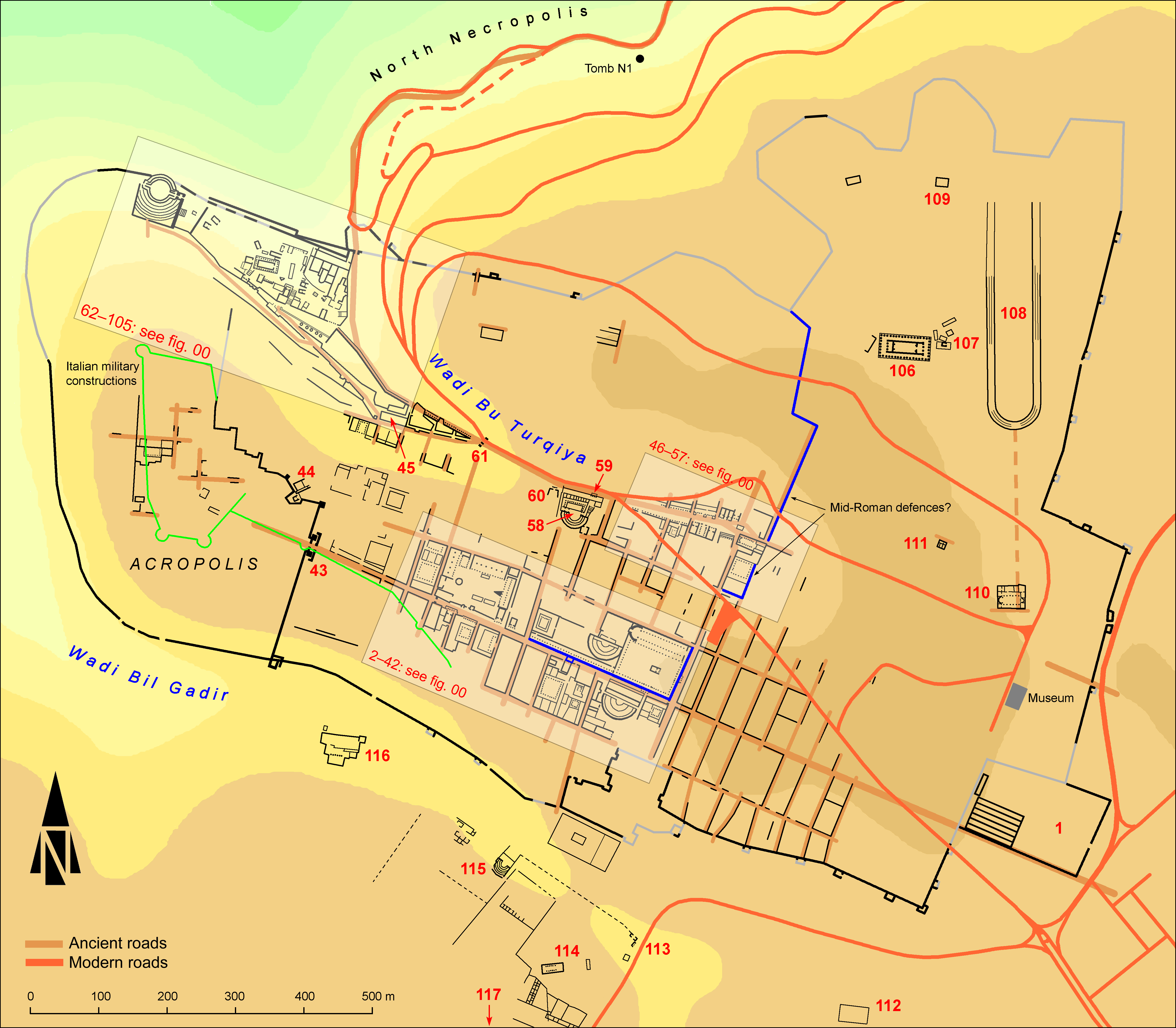EpiDoc XML: GVCyr0592
Source description
Support: Wall of the main hall of a rock-cut tomb, beside a loculus.
Layout: Lightly painted with charcoal.
Letters: Average height not registered; small capitals, irregular in shape and height, with clear spaces between them; lunate epsilon and sigma.
Date: Second half of first century BC or first century AD (?) (context, lettering).
Findspot: Found in 2006 at Cyrene ➚: in the South Necropolis, "Carboncini Tomb" (Tomb S147), betwen fourth and fifth loculus of right side in corridor AB.
Place of origin: Findspot.
Last recorded location: Studied in 2006 by A. Cinalli during the survey of the Archaeological Mission in Cyrenaica of the University “G. D’Annunzio” of Chieti in Shahat, at the mentioned place of South Necropolis. Not seen by IGCyr team.
Text constituted from: Transcription from first editor and photographs (CDL).
Bibliography
New in GVCyr2.
Cinalli 2016, pp. 202-203, whence SEG, 64.2023; Cinalli 2018 (ph.); Favi 2019; Dobias-Lalou, BE 2019.557.
Text
Apparatus
2: δὲ ⸢γ⸣ῆ. Γῆ Dobias-Lalou, BE from photograph δὲ ⸢γ⸣ῆ. Γῆ Favi 2019; δ' ἔβη γῆ<ν> Cinalli 2016
3: ⸢εἴ⸣ Favi 2019, Dobias-Lalou, BE: ἤ Cinalli 2018
5: Χαῖρε Cinalli 2018 or [ὑγίαιν]ε Cinalli 2018
French translation
Moi, le cadavre, je suis poussière. Mais poussière est la terre. Mais la terre est déesse. Si la Terre est quelque chose de divin, alors un cadavre est divin aussi.
Adieu Philesô, fille d'Hilarion, âgée de sept ans.
English translation
Translation by:
I, a corpse, am dirt. But dirt is earth. But earth is god. If Earth is something divine, then a corpse is god too. (transl. F. Favi).
Farewell Phileso, daughter of Ilarion, aged seven.
Italian translation
Io, un cadavere, sono sudiciume. Ma sudiciume è la terra. E la Terra è dio. Se la Terra è qualcosa di divino, allora anche un cadavere è divino.
Addio Philesò, figlia di Ilarion, di sette anni.
Commentary
The epitaph for Phileso, Ilarions’ daughter, reproduces a quotation of a well-known epigram presented as a syllogism by Pseudo-Epicharmus (fr. 297 K.-A. εἰμὶ νεκρός· | νεκρὸς δὲ κόπρος, γῆ δ’ ἡ κόπρος ἐστίν· | εἰ δὴ γῆ θεός ἐστ’, οὐ νεκρός, ἀλλὰ θεός). The same text is attested in four other inscriptions (GV 1126 from Eretria, 3rd/2nd century BC; GV 1941 from Thisbe 2nd/3rd century AD; CIL VI 29609 from Rome, 1st century AD; CIL VI 35887 from Rome 2nd/3rd century AD). According to Cinalli 2018, p. 86, the inscription from Cyrene adheres most closely to the literary model, since the crudity of κόπρος is preferred to κόνις/cinis, present in the other epigraphic parallels. Favi persuasively improved the text: he intended νεκρός as a substantive referred to Phileso and emended the otherwise too poetic construction βαίνω with accusative of the l. 2, restoring the correct order of the third sentence with δέ in second position. At l. 4 he restored the syllogism by interpreting ἠ as a conditional particle, instead of a disjunctive conjunction, suggesting that ἤ might be a dialectal form of εἰ. Dobias-Lalou (Dobias-Lalou, BE 2019.557 thinks that it is more simply due to hypercorrection.
At line 5, the surviving ε is the end of an imperative: χαῖρε fits better the space available than ὑγίαινε, although the latter is very frequent in this tomb and in other ones.
The name Phileso is attested in Egypt (I.Syringes 641; SEG 2.855), whereas the name Ilarion has occurrences only in Central and Northern Greece, Asia Minor, and Italy.
In view of the lettering, the suggested date (late Hellenismus) should be lowered, according to Dobias-Lalou.
Metrical commentary: the rythm should be based upon iambic dipodies, like in the original. However, there are many irregularities, which forbid to draw a regular schema. The cutting out proposed above is very tentative.
CC BY-NC-SA 4.0 Deed Attribution-NonCommercial-ShareAlike 4.0 International License.
All citation, reuse or distribution of this work must contain a link back to DOI: https://doi.org/10.60760/unibo/igcyrgvcyr2 and the filename (IGCyr000000 or GVCyr000), as well as the year of consultation.
